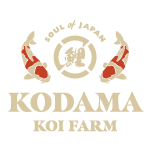Hosokai Koi Farm
Video Interview with Hosokai Koi Farm
I am Masaru Hosokai of Hosokai Koi Farm. Here, we breed Gosanke, Hikari Moyo, and also Asagi, Shusui, Goshiki, Koromo. We are aiming to make a koi that can be presented in competitions. It isn't easy competing in the world of Gosanke, but we are working hard to improve the quality of our farm’s Gosanke. Please, drop by when you visit Niigata. Thank you.
Learn More About Hosokai Koi Farm
Owner(s): Masaru Hosokai
Founded: 1971
Specialty: Asagi, Goshiki, Shusui, Goshikishigure, and more
Description: The farm has the reputation of quality Asagi from his father's time. The quality of the scalation is very beautiful. His recent invention is for sure "goshikishigure," the mix of Goshiki and Ochibashigure.
Interview with Hosokai Koi Farm
Hosokai Koi Farm
by Mamoru Kodama
This time I visited the Hosokai Koi Farm that is famous for Asagi and I interviewed him about his Asagi production.
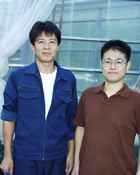
Masaru Hosokai, son of Mr. Hosokai with Taro Kodama
Kodama:
Please share with us how your farm started.
Hosokai:
My family has engaged in farming rice for generations in this Wakatochi area of Ojiya city. But because the rice farming skill has innovatively improved and the rice, our staple food, was overproduced, the government developed the policy of discouraging rice production. In 1970, the government offered a bounty of $1,300 per acre to the farmers who stopped farming rice. I was looking for something useful for humans rather than overproduced rice and switched to Nishikigoi production.
Kodama:
Did you turn the paddy fields to koi ponds and start the business?
Hosokai:
Yes. At the time, there was no heavy equipment like now. My wife, all the family members, and I dug the paddy fields with scoops and turned them to ponds. It was such hard work. But I liked koi by nature and always wanted to do koi business. So it was a good opportunity for me.
Kodama:
I see. It has been 35 years since 1970.
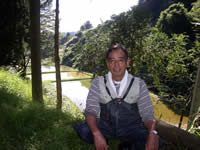
Shouichi Hosokai
Hosokai:
Yes. So Hosokai Koi Farm has 35 years of history.
Kodama:
What did you breed at first?
Hosokai:
It was Kohaku and Sanke. Then, gradually I added other varieties like Ogon and Kujaku to be a better breeder.
Kodama:
When did you start raising Asagi?
Hosokai:
It was about 1983. A breeder called Mr. Watada was famous for Asagi. He decided to quit the koi business. I received his parent stock of Asagi and added it to my product lines.
Kodama:
Was Asagi suitable for your clay quality? Was that why you chose Asagi?
Hosokai:
Not necessarily. Asagi is bred better at places of sand and gravel such as Shiozawa and Uonuma areas. My farm is clay and good for Kohaku and Sanke, but not for Asagi and Showa.
Kodama:
Koi has so many varieties, and each variety has its own suitable soil quality. It is common to breed the right varieties for suitable soils. But your idea seems to be opposed to the common idea, isn't it?
Hosokai:
Yes, it is common sense to breed suitable varieties for the soil you have and never to breed ones that are not suitable for the soil. But I saw it differently. My idea was that if koi could maintain the beauty even under unsuitable conditions, the bloodline was genuine.
Kodama:
OK. Then, what was the result of raising Mr. Watada's Asagi?
Hosokai:
At the time, Mr. Watada's Asagi was one of the top-quality levels in Niigata. So I strongly believed that they would breed high-quality ones even at my farm. But the parents were expensive. It was a big risk and a challenge to me.
Kodama:
May I ask how expensive?
Hosokai:
I invested more than 20,000,000 yen (about U.S. $200,000) for the 10 pairs.
Kodama:
What was the result?
Hosokai:
Very successful with the parents. Starting from the 17th All Japan Nishikigoi Show (1986), my Asagi have won many awards one after another. The representative Asagi is seen in the picture to the right. This kind of wonderful Asagi was produced even at my farm of clay.
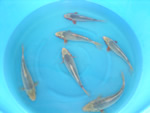
Tosai
Kodama:
Is there anything special you did to breed the Asagi for your place? What are the difficulties in breeding Asagi?
Hosokai:
Because I wanted to breed something that is not for my farm, I know I had to think differently. I had to raise them differently.
Kodama:
Give me some examples.
Hosokai:
Intensity of accom-modation is the key. In other words, I kept fewer of them in the pond so the water does not get cloudy with mud. For example, I put only 500 Asagi in the pond that can usually accommodate 1000 Kohaku. This way, the pond can maintain clean water without getting clouded. The cloudy water means that koi in the pond get influenced by the clay quality there. So by reducing the number of koi released to the pond, I stopped the cloudiness of water and prevented koi from getting the influence of the clay.
Kodama:
I see, when you put many koi the water becomes cloudy. That is why you release only a limited number of koi. That is simple, but wise.
Hosokai:
I do many more things, but the most important thing is that the quality of koi must be excellent.
Kodama:
It is your style to breed excellent koi, even though the surrounding condition is not preferable, by adding "your own technique" to "high-quality Nishikigoi." I am impressed.
Hosokai:
Thank you and I think that is my style. One can farm anything even in barren lands like deserts with the intelligence and techniques of human beings. I am sure we can breed excellent koi with our serious study even in an unsuitable land.
Kodama:
Wonderful idea. Now please tell us more about your Asagi. Is the Best in Variety koi in the picture on page 15 Narumi Asagi?
Hosokai:
Yes, it is. This is a representative of the Narumi Asagi.

Winner of Best in Variety at All Japan Nishikigoi Show Representative Asagi of Hosokai Koi Farm
Kodama:
What is the difference between Narumi and Konjyo Asagi?
Hosokai:
My female parent is Narumi Asagi and my male parent is Konjyo Asagi. So when I breed them, I get both types.
Kodama:
What is the ratio?
Hosokai:
I get 80% of Narumi Asagi and 20% of Konjyo Asagi.
Kodama:
How can you differentiate each other?
Hosokai:
Please look at the four pictures. Picture A is Narumi Asagi and C is Konjyo Asagi. Picture B is Narumi Asagi and D is Konjyo Asagi. First, please compare A and C. They are the pictures when the koi are two years old. Scales of Asagi on picture A form the Tamashibori pattern. Narumi is named after this pattern. This is the characteristic of Narumi Asagi. Now please look at picture C. The coloration of the back looks like it was painted in Konjyo (navy blue) color with a brush. Also pictures B and D show us the difference when they grow up. In picture B, each scale is clearly divided with Fukurin. In picture D on the other hand, scalation is there, but it is colored in Konjyo (navy blue) over all. These are the differences between the two types of Asagi.

Type(A)

Type(B)

Type(C)

Type(D)
Kodama:
Narumi Asagi and Konjyo Asagi from Hosokai Koi Farm are brothers and sisters, aren't they!?
Hosokai:
Originally, they were two different varieties, but in the long history, they got synchronized. At my farm, too, when I started Asagi in 1983, I crossed Narumi and Konjyo; they both come out.
Kodama:
I understand it well. Then, how many Asagi do you breed?
Hosokai:
Because the body is big, one pair of Asagi can breed as many as 500,000 eggs. I release the hatched 200,000 fry to five ponds, each of whose size is about 0.5 acre. I cull them three times by fall. At every culling, we eliminate 50%.
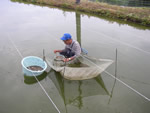
Mr. Hosokai at culling
Kodama:
How many do you eventually select?
Hosokai:
We select 2000?3000 out of 200,000.
Kodama:
And you winter them in the greenhouse?
Hosokai:
That is correct. By spring, I choose 10% of them to raise to two years old and sell the rest of the 90%. My Asagi seems to be popular inside and outside of Japan. I think 50% goes out of Japan and 50% goes to the Japanese market.
Kodama:
Thank you very much for your time today.
Second Interview with Hosokai Koi Farm
Hosokai Koi Farm
I interviewed Mr. Hosokai and introduced his Asagi in the July/August issue of 2005. But this shows only a part of his farm. He has another excellent variety, which is Goshiki. Because his Goshiki have won many top awards at the All Japan Nishikigoi Show, it is popular among Japanese koi hobbyists.
Kodama:
Please tell us about the famous "Goshiki of the Hosokai Koi Farm."
Hosokai:
It is after all the "Kokugyo Prize" (Best in Size) that makes your koi recognized as excellent. But it is difficult to reach that level. The koi in picture 1 is my representative Goshiki. As you can see, the hi is truly red and very clean.
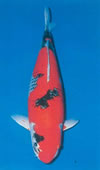
1. Winner at All Japan Nishikigoi Show
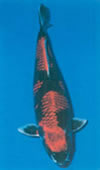
2. Kuro Goshiki that holds strong dark elements
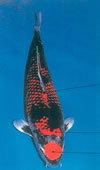
3. Enhanced the Hi
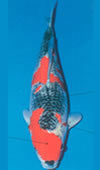
4. Decreased dark elements
Kodama:
It is beautiful. It is common that sumi starts showing up on the hi plate.
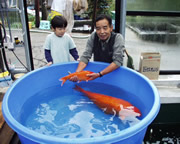
Introducing a jumbo Benigoi blood to make his Goshiki larger.
Hosokai:
My koi are originally from the Kuro Goshiki family. So it tends to get dark all over the body. Please look at Picture 2. This is a parent. As you can see, it is a dark koi; its offspring also tends to darken its hi pattern. It took me a while to remove this.
I tried to remove the black and improve my koi. On page 25 see the difference from Picture 3 to 4.
Kodama:
I see. You made a great amount of effort to improve the beauty. How did your Goshiki start?
Hosokai:
In 1992, Mr. Minuma was breeding good Kuro Goshiki. I got a female from him. And I got a male from Mr. Aizawa. From the pair, I got the koi in Pictures 1, 3, and 4.
Kodama:
Observing the development in Pictures 2, 3, and 4, we can see that the hi is getting brighter.
Hosokai:
Yes. Because I used Mame Goshiki as a male parent, the body tends to get whitish like Picture 4. I think the sumi degenerates from hi plates.
Kodama:
What kind of ideas do you have to improve your Goshiki?
Hosokai:
At the All Japan Nishikigoi Show, there is a title for Best Koi in each variety. To win the title, koi must be at least 75-80 cm (30-32in). For koi to grow that big, I have to introduce the character to koi. I have Benigoi (see picture on page 23) that grows more than 1 m (40in). I am planning to introduce the blood of this Benigoi so that all Goshiki can grow bigger.
Kodama:
I am impressed with your challenge. How many Goshiki do you breed now?
Hosokai:
I have two pairs. I release 500,000 fry to 5 ponds, which are about 1.7 acre total. I cull them three times and harvest 5000 to 6000 excellent ones.
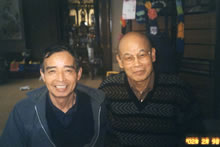
Hosokai and Kodama, 40 years of friendship
Kodama:
How do you cull Goshiki?
Hosokai:
Asagi is difficult, but Goshiki is easy. It is just to choose ones with a nice hi pattern.
Kodama:
What is the difficult part of Goshiki?
Hosokai:
In my case, when the hi quality is not good, sumi appears on the hi plate because I breed Kuro Goshiki. So it is important to choose ones with thick and good hi quality. In culling fry, the hi is still thin and orange; I pay full attention to the quality.
Kodama:
I see. When the bloodline is different, the culling method will get different as well.
Hosokai:
When the blood of Benigoi is introduced, the culling method will become different again. As breeders, it is critical to choose good ones out of many selections. Not to throw away good ones is the most important skill required to breeders, I think.
Kodama:
Can you learn the skill easily?
Hosokai:
It took me 20 years to learn how to cull right for Asagi and 12 years for Goshiki. I do not think you can learn even a tip of Nishikigoi breeding techniques in a few years.
Kodama:
Niigata breeds such beautiful koi because breeders in Niigata have the technique based on the 30 to 40 years of experience.
Hosokai:
Absolutely. I pass my techniques to my sons. My sons hand it over to grandsons. So in the Nishikigoi industry of Niigata, those techniques from the ancestors have been transferred over the generations. This is the reason why Niigata can breed the most beautiful Nishikigoi in the world.
Kodama:
Thank you very much for your time today.
Tips on Purchasing from Hosokai Koi Farm
2. Because Hosokai Goshiki is the Kuro Goshiki line, the entire body tends to get dark. And the hi is finished to the contrary of the black. This is the character of his koi. Make sure to feed color-enhancing food such as Champion.
3. His koi turns out beautiful when it becomes more than 5 years old. Please keep that in mind. In other words, his koi will be show quality when it is big rather than when it was small and young.
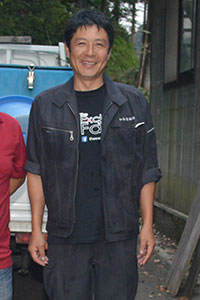
- Sorry, this product cannot be purchased.
Showing all 3 results
-
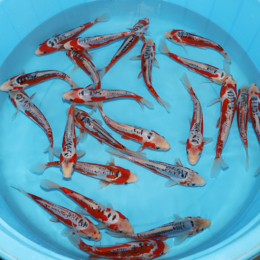
Shusui – koi #w0220st060
$89.00 Add to cart -
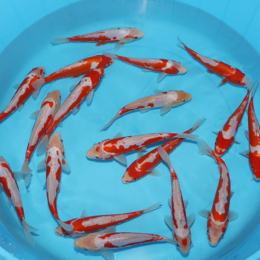
Kousui – koi #w0220st059
$89.00 Add to cart -
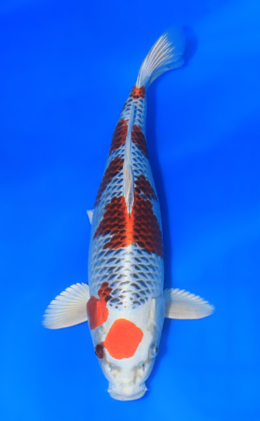
Kujyaku – koi #v1012n009
$1,500.00 Add to cart
Can't find the koi you're looking for? Click here to use our koi request form
Request the Koi of Your Dreams
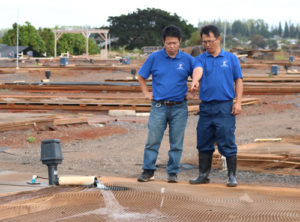
What can we help you find?
Let us know more about what you are searching for and we will look into our inventory to help you find the perfect koi. Tell us a description, variety, size range, and price range you are searching for.
We have a large stock of koi that are not listed on our website and we can also look when we are visiting Niigata, Japan. Complete this form and we will follow up with you directly.
Koi Request Form
